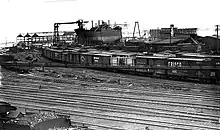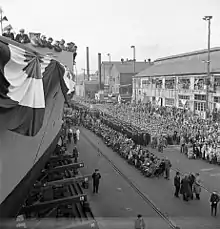Naval Shipyards, York (Upper Canada)
Naval Shipyards, York (Upper Canada) was one of the shipyards of the Royal Navy on Lake Ontario.
| Naval Shipyards, York | |
|---|---|
| York, Upper Canada | |
.jpg.webp) Work on HMS Isaac Brock at the York Naval Shipyards, April 1813. | |
| Type | Shipyard |
| Site information | |
| Controlled by | Royal Navy |
| Site history | |
| Built | 1793–1798 |
| In use | 1790s–1813 |
| Battles/wars | Battle of York |
| Garrison information | |
| Garrison | Fort York |
History
Establishment
The yards was called for by Lieutenant Governor John Graves Simcoe in 1793 [1] and operated from 1798 long before the town of York was populated and up to the War of 1812. The yard was on the western edge of the town (east of the Fort Rouille) and located south of Front Street on the shores of Lake Ontario west of Bay Street (today the rail tracks south of Union Station). Ships were built along the sand shores using the trees from the forests inland and launched into Toronto Bay. While shipbuilding resumed in York (and later in Toronto), the naval yards did not build any other navy ships after 1813 and abandoned and likely moved to a safer and more protected location in Kingston Royal Naval Dockyard.
The yard built a few ships:
- Toronto – schooner 1813 and wrecked 1817
- HMS Prince Regent – schooner launched 1812 and renamed HMS Beresford in 1813, as HMS Netley 1814 and finally base ship HMS Niagara; broken up 1843
- HMS Isaac Brock – incomplete frigate 1813
Early private builders
Cooper's Wharf slip was another early 19th century shipbuilder in Toronto and remained in operations until 1845.

Numerous builders at mouth of Rouge River 1810–1856 [2] After the War of 1812, shipbuilding yards in Toronto were typically held in private hands.[3]
Polson Iron Works Limited was established in Toronto in 1883, was a major builder of steamers into the 1900s. Located at the foot of Sherbourne Street, Polson produced around 150 assorted vessels,[4] including ten steel-hulled minesweepers for the Royal Canadian Navy and Royal Navy, and six cargo vessels during World War I. The company declared bankruptcy shortly after the end of the war and closed in 1919.
Several other ship builders were also based at the Bathurst Street Wharf. They include:
- Doty Engine Works 1890 new shipyard at Lakeshore and Spadina
- Bertram Engineering Works 1893 Doty yard changes owners
- Canadian Shipbuilding Company 1905 – acquired Bertram site but company fails by 1908
- Toronto Shipyards 1908 – took over from Canadian Shipbuilding and remains in operations until 1910
- Thor Iron Works 1913 – acquire vacant Toronto Shipyards
- Dominion Shipbuilding and Repair Company Limited 1917 – renamed from Thor and operated at both Spadina Avenue and Bathurst Street as well as Keating Channel building mostly cargo ships for Canadian and overseas buyers as well as yacht Oriole IV which later became HMCS Oriole; folded 1920 after strike with last two ships completed by Collingwood Shipyards
World War II

In the 20th century, shipbuilding activity remained dormant (other than Toronto Drydock Company) until the start of World War II with demand for war ships.[5] Several shipbuilding enterprises emerged including:
- Dufferin Shipbuilding Company 1940 – acquires Keating Channel site from the former Dominion Shipbuilding site
- Toronto Shipbuilding Company 1941 – renamed from Dufferin after take over by the Canadian government
- Redfern Construction Company 1943 – renamed from Toronto Shipbuilding and closed 1945
See also
References
- "Archived copy". Archived from the original on 27 March 2012. Retrieved 21 December 2011.CS1 maint: archived copy as title (link)
- http://shipbuildinghistory.com/canadayards/redfern.htm
- http://shipbuildinghistory.com/canadayards/polson.htm
- http://shipbuildinghistory.com/canadayards/redfern.htm